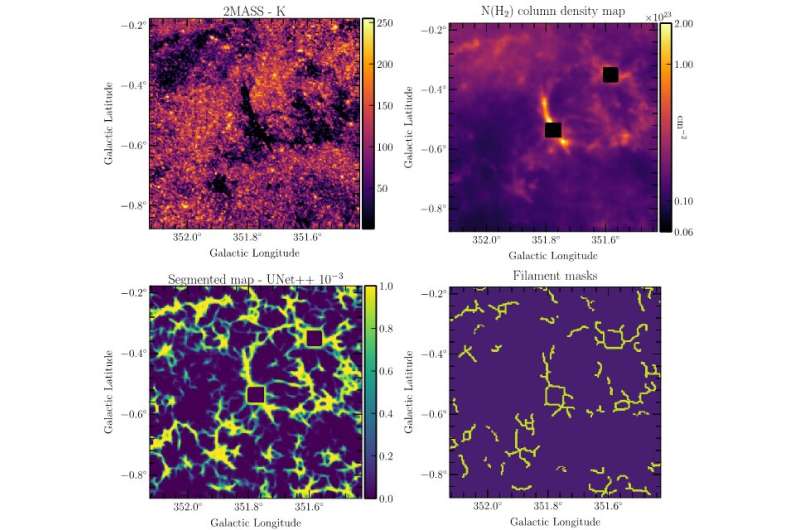Example of a galactic plane area of the synthesis of the result obtained. The top left image shows the area seen in near-infrared emission (K-band, 2MASS survey). This data was not used for training but is used here for the empirical validation of the result obtained through supervised learning and segmentation (bottom left image). This image shows the probability map for a pixel to belong to the "filament" class, the structure we were trying to identify from the training. The top right image shows the data used for this study, showing the column density distribution (amount of material on the line of sight) obtained from the Herschel space infrared satellite data. The black squares show the saturated areas where physical information cannot be obtained. The bottom right image shows the filaments known before our study, whose structures were used as masks for supervised learning using the convolutional networks Unet and Unet++. Credit: Astronomy & Astrophysics (2022). DOI: 10.1051/0004-6361/202244103
Star formation in galaxies takes place in filaments composed of gas (mainly hydrogen) and small solid particles called interstellar dust, which is mainly carbon. Depending on the location of these filaments and their physical properties (density, temperature) they can be difficult to detect in the data. In particular, low density filaments or filaments located in areas of very high emission are generally not detected.
In an innovative and interdisciplinary approach, a team in which some CNRS laboratories are involved, has tested the interest of supervised machine learning to try to detect filaments located in the plane of our galaxy. This approach is based on existing results of filament detection using classical extraction methods.
The extracted filaments are used to train convolutional networks of the Unet and Unet++ type. The trained model learns to recognize filaments and then allows researchers to create an image of the galactic plane in which each pixel is represented by its probability (between 0 and 1) of belonging to the learned filament class.
The results of the learning approach show that this method can detect filaments that were not previously identified by the usual detection methods. New filaments are detected and can be confirmed by an empirical approach using data available at other wavelengths that are currently not used in the learning process.
The findings are published in the journal Astronomy & Astrophysics.
The aim of this project, called BigSF, is to study star formation in our galaxy by combining the large amount of available data with machine learning.
More information: A. Zavagno et al, Supervised machine learning on Galactic filaments, Astronomy & Astrophysics (2022). DOI: 10.1051/0004-6361/202244103
Journal information: Astronomy & Astrophysics
Provided by CNRS
























